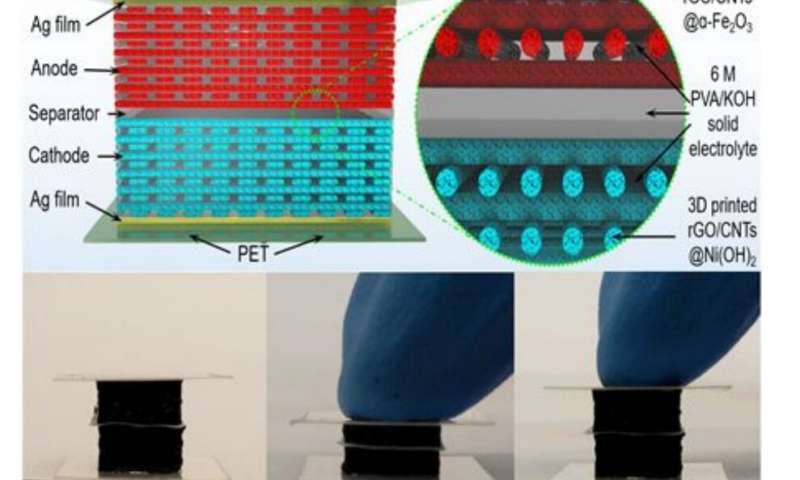3D printing is continually associated with the energy industry, from wind turbines to fuel cells and a variety of different casings for batteries. Now, researchers from Singapore and China are exploring ways to 3D print unique structures like free-standing 3D printed electrodes—with a variety of different structural designs.
Outlining the details of their study in the recently published “3D Printed Compressible Quasi-Solid-State Nickel-Iron Battery,” the authors (led by Hui Ying Yang of Singapore University of Technology and Design) share more about the innovative design meant to supply high-energy density and improved stability—with 10,000 charge-recharge cycles.
As innovations within the 3D printing industry continue to emerge at an accelerated rate due to user needs—and their impressive refusal to accept limitations within hardware, software, and materials—progress is being made for improved energy storage via batteries. In this latest study, 3D printing was used for rapid prototyping of battery electrodes featuring a range of different shapes, with varying layers and patterns.
While the use of graphene oxide (GO) flakes has been common due to stable dispersion and tunable mechanical properties, numerous additives are required to reach a suitable viscosity level. Researchers have continued to explore reduced GO materials to make “ultra-lightweight structures,” that can be easily compressed and are also conductive.
For this study, the authors used a combination of GO flakes with carbon nanotubes, soaking the 3D printed lattices in ammonia and nickel sulfate, resulting in Ni(OH)2 nanoflakes on the surface; however, in experimenting with iron nitrate and iron chloride on the lattices, they discovered the emergence of porous αFe2O3 nanorod arrays.
Ultimately, as Yang and the other researchers moved forward in the study, they were able to produce a quasi-solid-state battery—tuned for the proper dimensions and the option of aqueous liquid or polymer gel potassium hydroxide for an electrolyte. With four devices attached to each other in succession, they were able to light up a blue LED successfully, proving that the battery was functional.
The battery offered the following unique features:
- Compression of 60 percent
- Excellent cycling stability (~91.3% capacity retentions after 10,000 charge-discharge cycles)
- Ultra-high energy density (28.1 mWh cm-3at a power of 10.6 mW cm-3)
[Source / Images: Phys.Org; ‘3D Printed Compressible Quasi-Solid-State Nickel-Iron Battery’]“Our work opens a new method for producing compression-tolerant energy-storage devices, which are expected to have promising applications in new generation stretchable/wearable electronics,” concluded the authors.
“Next, we will further study the 3D printed aqueous rechargeable batteries with high energy density and high discharge platforms, such as Zn-air batteries, and so on.”
Subscribe to Our Email Newsletter
Stay up-to-date on all the latest news from the 3D printing industry and receive information and offers from third party vendors.
You May Also Like
Gorilla Sports GE’s First 3D Printed Titanium Cast
How do you help a gorilla with a broken arm? Sounds like the start of a bad joke a zookeeper might tell, but it’s an actual dilemma recently faced by...
Nylon 3D Printed Parts Made More Functional with Coatings & Colors
Parts 3D printed from polyamide (PA, Nylon) 12 using powder bed fusion (PBF) are a mainstay in the additive manufacturing (AM) industry. While post-finishing processes have improved the porosity of...
$25M to Back Sintavia’s Largest Expansion of Metal 3D Printing Capacity Since 2019
Sintavia, the digital manufacturing company specializing in mission-critical parts for strategic sectors, announced a $25 million investment to increase its production capacity, the largest expansion to its operations since 2019....
Velo3D Initiates Public Offering in a Bid to Strengthen Financial Foundations and Drive Future Growth
Velo3D (NYSE: VLD) has been among a number of publicly traded 3D printing firms that have attempted to weather the current macroeconomic climate. After posting a challenging financial report for 2023,...
































